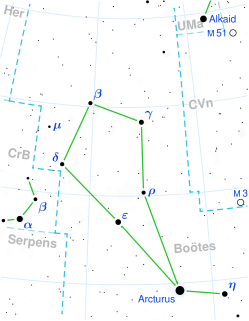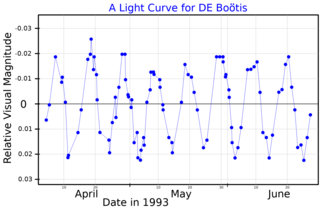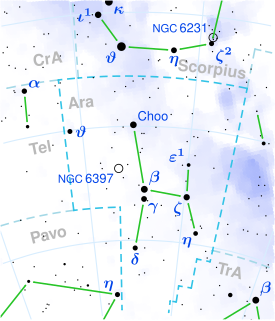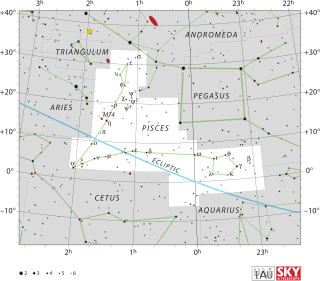Related Research Articles

Gamma Cancri, or γ Cancri, is a star in the northern constellation of Cancer. It is formally named Asellus Borealis, the traditional name of the system. Based on parallax measurements, it is located at a distance of approximately 181 light years from the Sun. The star is drifting further away with a radial velocity of 29 km/s. In 1910 this star was reported to be a spectroscopic binary by O. J. Lee, but is now considered a single star. Since it is near the ecliptic, it can be occulted by the Moon and, very rarely, by planets.
Zeta Trianguli Australis is a spectroscopic binary in the constellation Triangulum Australe. It is approximately 39.5 light years from Earth.
Rho Tucanae is a binary star system in the southern constellation of Tucana. It is visible to the naked eye with a combined apparent visual magnitude of +5.38. Based upon an annual parallax shift of 24.37 mas as seen from Earth, it is located 131 light years from the Sun.
40 Aurigae is a binary star in the constellation Auriga. Its apparent magnitude is 5.345, meaning it can just barely be seen with the naked eye. Based on parallax estimates made by the Hipparcos spacecraft, the system is located some 340 light-years away.

12 Boötis is a spectroscopic binary in the constellation Boötes. It is approximately 122 light years from Earth.

Iota Cancri is a double star in the constellation Cancer approximately 300 light years from Earth.
61 Cancri is the Flamsteed designation for a visual binary star system in the northern constellation Cancer. The pair have a combined apparent magnitude of 6.25, which means 61 Cancri is faintly visible to the naked eye. Based upon parallax measurements, the system is approximately 181 light years away from Earth.
81 Cancri (Pi1 Cancri, π1 Cancri) is a stellar system that lies approximately 66 light-years away. The main component of the system is a close binary, while a brown dwarf binary is located at a wide separation.
HR 9038 is a triple star system located thirty-five light-years away, in the constellation Cepheus. Component A is a spectroscopic binary system with an orbital period of 7.753 days and a combined stellar classification of K3 V. Component B is a red dwarf star that orbits the primary pair every 290 years.

HR 5553 is a binary star system located thirty-eight light-years away from the Sun, in the northern constellation Boötes. It has the variable star designation DE Boötis, and is classified as an RS Canum Venaticorum variable that ranges in apparent visual magnitude from 5.97 down to 6.04, which is bright enough to be dimly visible to the naked eye. The system is drifting closer to the Sun with a radial velocity of −30 km/s, and is expected to come as close as 26.9 light-years in 210,000 years.
HD 213429 is a spectroscopic binary system in the equatorial constellation of Aquarius. It has a combined apparent magnitude of 6.16 and is located around 83 light years away. The pair orbit each other with a period of 631 days, at an average separation of 1.74 AU and an eccentricity of 0.38.
HD 200375 is a binary star system in the equatorial constellation of Aquarius. Their orbit does not yet have a unique solution available.

HD 150136 is a multiple star system in the southern constellation of Ara, around 4,300 light years away. It is the brightest member of the faint open cluster NGC 6193, part of the Ara OB1 association.

HD 106112, also known as CO Camelopardalis, is a star in the constellation Camelopardalis. It has an apparent magnitude of about 5.1, meaning that it is just barely visible to the naked eye. Based upon parallax measurements made by the Hipparcos spacecraft, this star is around 177 light years away from the Sun.
Omega Draconis, Latinized from ω Draconis and also known as 28 Draconis, is a binary star in the constellation of Draco. The system is fairly close, and is located about 76 light-years away, based on its parallax.

Sigma Piscium is a main-sequence star in the zodiac constellation of Pisces. It has an apparent magnitude of +5.50, meaning it is barely visible to the naked eye, according to the Bortle scale. While parallax measurements by the Hipparcos spacecraft give a distance of approximately 430 light years, dynamical parallax measurements put it slightly closer, at 368 light-years from Earth.
39 Draconis is a wide binary star system in the northern circumpolar constellation of Draco. It has the Bayer designation b Draconis, while 39 Draconis is the Flamsteed designation. This system is visible to the naked eye as a dim, white-hued point of light with an apparent visual magnitude of 5.0. Parallax measurements made by the Hipparcos spacecraft put it at a distance of 184 light-years, or 56 parsecs away from the Sun. The system is moving closer to the Earth with a heliocentric radial velocity of -24.5 km/s.
Lambda Lupi, Latinized from λ Lupi, is a triple star system in the southern constellation of Lupus. It is visible to the naked eye with a combined apparent visual magnitude of 4.04. Based upon an annual parallax shift of just 4.20 mas as seen from Earth, it is located roughly 800 light years from the Sun. The system has a peculiar velocity of 27.4±4.9 km/s relative to its neighbors, making it a candidate runaway star system. It is a member of the Upper Centaurus–Lupus sub-group in the Scorpius–Centaurus OB association.
66 Eridani is a binary star in the constellation of Eridanus. The combined apparent magnitude of the system is 5.12 on average. Parallax measurements by Hipparcos put the system at some 309 light-years away.
References
- 1 2 3 4 5 van Leeuwen, F.; et al. (2007). "Validation of the new Hipparcos reduction". Astronomy and Astrophysics. 474 (2): 653–664. arXiv: 0708.1752 . Bibcode:2007A&A...474..653V. doi:10.1051/0004-6361:20078357. S2CID 18759600.
- 1 2 3 4 5 6 7 Konacki, Maciej; et al. (2010). "High-precision Orbital and Physical Parameters of Double-lined Spectroscopic Binary Stars—HD78418, HD123999, HD160922, HD200077, and HD210027". The Astrophysical Journal. 719 (2): 1293–1314. arXiv: 0910.4482 . Bibcode:2010ApJ...719.1293K. doi:10.1088/0004-637X/719/2/1293. S2CID 119253596.
- 1 2 Mermilliod, J.-C. (1986). "Compilation of Eggen's UBV data, transformed to UBV (unpublished)". Catalogue of Eggen's UBV Data. Bibcode:1986EgUBV........0M.
- ↑ "* 75 Cnc". SIMBAD . Centre de données astronomiques de Strasbourg . Retrieved 21 August 2017.